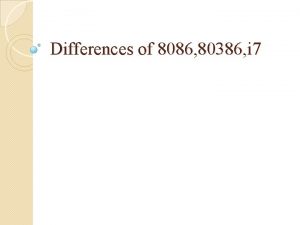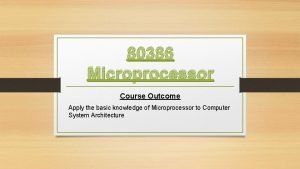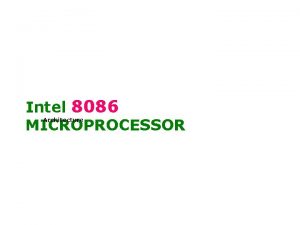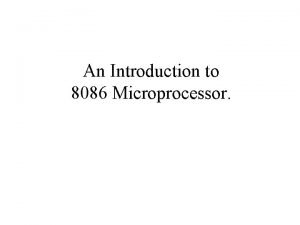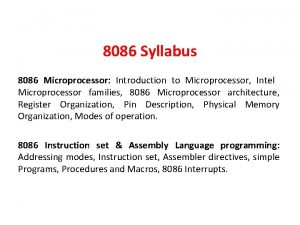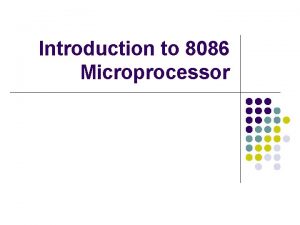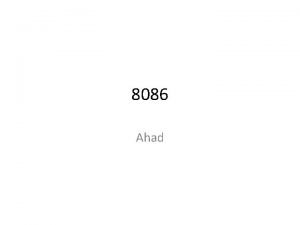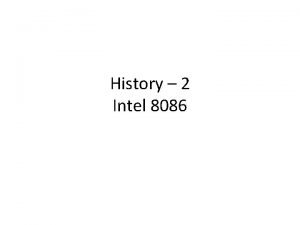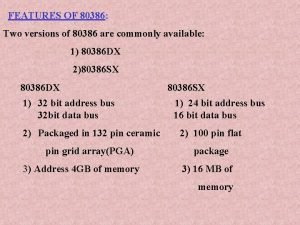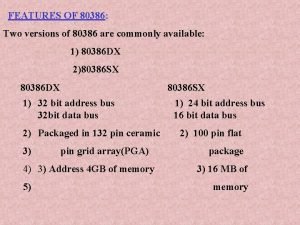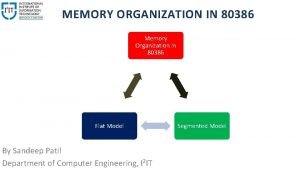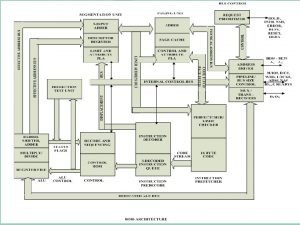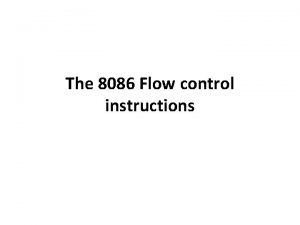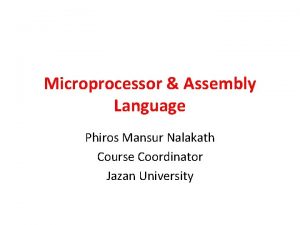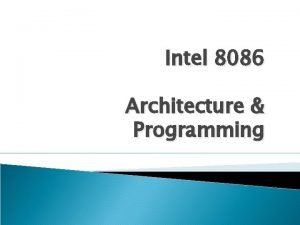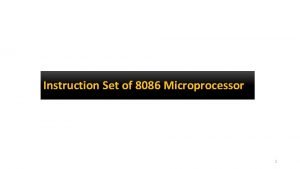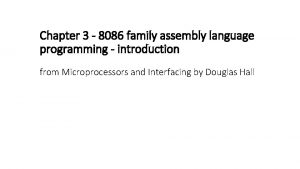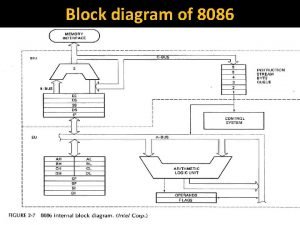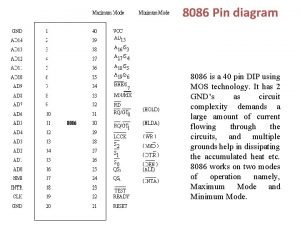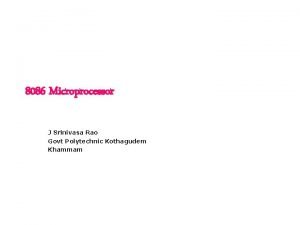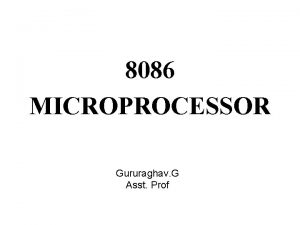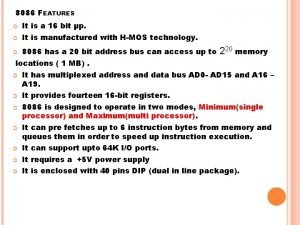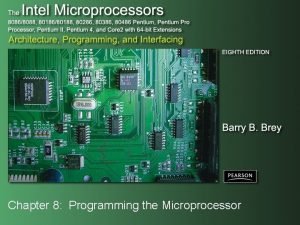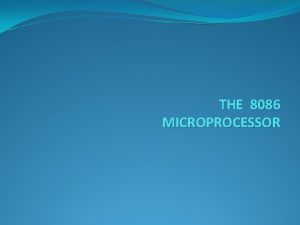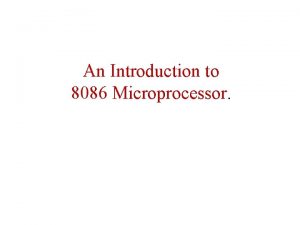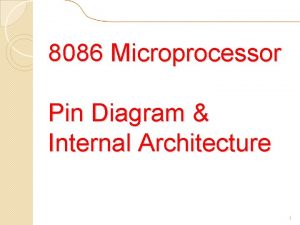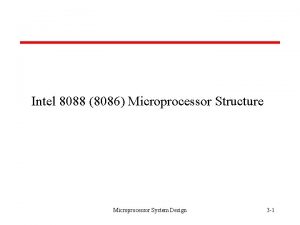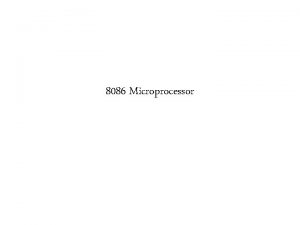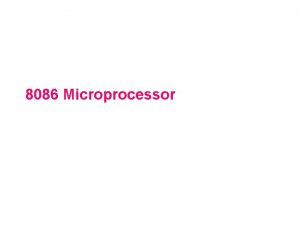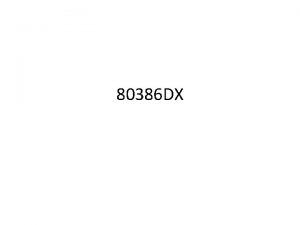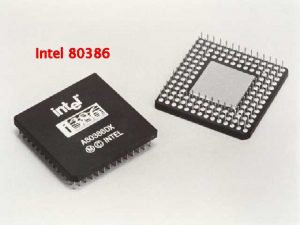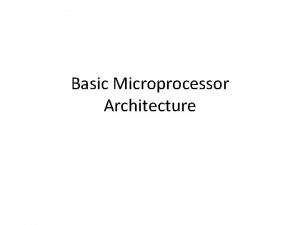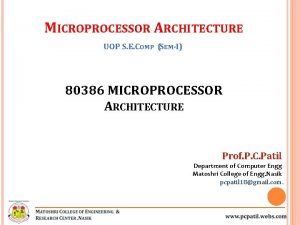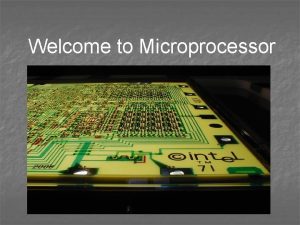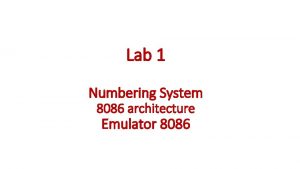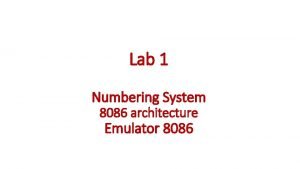UnitI 80386 DX Architecture History of 8086 microprocessor


























- Slides: 26

Unit-I 80386 DX Architecture �History of 8086 microprocessor, Concept of segmentation in 8086, 8086 Register block diagram � 80386 DX functional Block Diagram, PIN Description, Register set, Flags, Physical address space, Data types

History of 8086

Architecture of 8086 �The architecture of 8086 includes �Arithmetic Logic Unit (ALU) �Flags �General registers �Instruction byte queue �Segment registers

EU & BIU �The 8086 CPU logic has been partitioned into two functional units namely Bus Interface Unit (BIU) and Execution Unit (EU) �The major reason for this separation is to increase the processing speed of the processor �The BIU has to interact with memory and input and output devices in fetching the instructions and data required by the EU �EU is responsible for executing the instructions of the programs and to carry out the required processing

Architecture Diagram

Execution Unit �The Execution Unit (EU) has �Control unit �Instruction decoder �Arithmetic and Logical Unit (ALU) �General registers �Flag register �Pointers �Index registers

Execution Unit �Control unit is responsible for the co-ordination of all other units of the processor. �ALU performs various arithmetic and logical operations over the data. �The instruction decoder translates the instructions fetched from the memory into a series of actions that are carried out by the EU.

Execution Unit - Registers �General registers are used for temporary storage and manipulation of data and instructions �Accumulator register consists of two 8 -bit registers AL and AH, which can be combined together and used as a 16 -bit register AX �Accumulator can be used for I/O operations and string manipulation

Execution Unit - Registers �Base register consists of two 8 -bit registers BL and BH, which can be combined together and used as a 16 -bit register BX. �BX register usually contains a data pointer used for based, based indexed or register indirect addressing. �Count register consists of two 8 -bit registers CL and CH, which can be combined together and used as a 16 -bit register CX. �Count register can be used as a counter in string manipulation and shift/rotate instructions.

Execution Unit - Registers �Data register consists of two 8 -bit registers DL and DH, which can be combined together and used as a 16 -bit register DX. �Data register can be used as a port number in I/O operations. �In integer 32 -bit multiply and divide instruction the DX register contains high-order word of the initial or resulting number.

Execution Unit - Registers

Execution Unit - Flags

Execution Unit - Flags

Flags �Conditional Flags: Set or reset by EU on the basis of the results of arithmetic or logic operation �Control Flags (TF, IF, DF)

Execution Unit - Pointers �Stack Pointer (SP) is a 16 -bit register pointing to program stack �Base Pointer (BP) is a 16 -bit register pointing to data in stack segment. BP register is usually used for based, based indexed or register indirect addressing. �Source Index (SI) is a 16 -bit register. SI is used for indexed, based indexed and register indirect addressing, as well as a source data addresses in string manipulation instructions. �Destination Index (DI) is a 16 -bit register. DI is used for indexed, based indexed and register indirect addressing, as well as a destination data addresses in string manipulation instructions.

Bus Interface Unit �The BIU has � Instruction stream byte queue � A set of segment registers � Instruction pointer

BIU – Instruction Byte Queue � 8086 instructions vary from 1 to 6 bytes �Therefore fetch and execution are taking place concurrently in order to improve the performance of the microprocessor �The BIU feeds the instruction stream to the execution unit through a 6 byte prefetch queue �This prefetch queue can be considered as a form of loosely coupled pipelining

Segment Registers �The memory of 8086 is divided into 4 segments namely � Code segment (program memory) � Data segment (data memory) � Stack memory (stack segment) � Extra memory (extra segment)

Different Areas in Memory �Program memory – Program can be located anywhere in memory �Data memory – The processor can access data in any one out of 4 available segments �Stack memory – A stack is a section of the memory set aside to store addresses and data while a subprogram executes �Extra segment – This segment is also similar to data memory where additional data may be stored and maintained

Segment Registers �Code Segment (CS) register is a 16 -bit register containing address of 64 KB segment with processor instructions. �The processor uses CS segment for all accesses to instructions referenced by instruction pointer (IP) register. �Stack Segment (SS) register is a 16 -bit register containing address of 64 KB segment with program stack. �By default, the processor assumes that all data referenced by the stack pointer (SP) and base pointer (BP) registers is located in the stack segment

Segment Registers �Data Segment (DS) register is a 16 -bit register containing address of 64 KB segment with program data. �By default, the processor assumes that all data referenced by general registers (AX, BX, CX, DX) and index register (SI, DI) is located in the data segment. �Extra Segment (ES) register is a 16 -bit register containing address of 64 KB segment, usually with program data. �By default, the processor assumes that the DI register references the ES segment in string manipulation instructions

Segment Registers

Memory Segmentation


20 -bit Physical address generation

Thank You!
 80386 pin diagram
80386 pin diagram Write features of 80386
Write features of 80386 8086 segment registers
8086 segment registers Internal architecture of 8086 microprocessor
Internal architecture of 8086 microprocessor 8086 architecture
8086 architecture Architecture of 8086
Architecture of 8086 Intel 8086 block diagram
Intel 8086 block diagram Architecture of 8086
Architecture of 8086 Descriptor table in 80386
Descriptor table in 80386 80386 features
80386 features Physical memory organisation of 8086
Physical memory organisation of 8086 What is the use of ldtr in 80386 microprocessor
What is the use of ldtr in 80386 microprocessor Addressing modes of 8086 microprocessor
Addressing modes of 8086 microprocessor If else in 8086
If else in 8086 Input signals in 8086 microprocessor
Input signals in 8086 microprocessor Why accumulators are used in microprocessor
Why accumulators are used in microprocessor 8088 pinout
8088 pinout Ror instruction in 8086
Ror instruction in 8086 Program development steps in 8086 microprocessor
Program development steps in 8086 microprocessor Block diagram 8086
Block diagram 8086 8088 pin diagram
8088 pin diagram Rep instruction in 8086
Rep instruction in 8086 8086 microprocessor
8086 microprocessor If segment address = 1005h
If segment address = 1005h Immediate addressing mode in 8086
Immediate addressing mode in 8086 Macros in 8086 microprocessor
Macros in 8086 microprocessor Assembler directives in 8086
Assembler directives in 8086
